
Key Takeaways
- 16% of respondents reported being not at all satisfied with the current education system.
- 53.5% of the general public and 49.7% of educators supported the AI-designed school system.
- The most popular AI proposal was to limit class sizes to 8 to 10 students, which was supported by 89% of the general public and 91% of educators.
- Budgeting, personal finance, and job search courses were the most popular classes that the AI suggested should be required before graduating high school.
The Future of Education?
In 1934, philosopher John Dewey said that “The purpose of education has always been to every one, in essence, the same – to give the young the things they need in order to develop in an orderly, sequential way into members of society.” This statement alludes to the idea that education is more than simply providing a basic knowledge of writing, reading, math, and science, but also the life skills needed to just be – the life skills needed to make it in the real world.
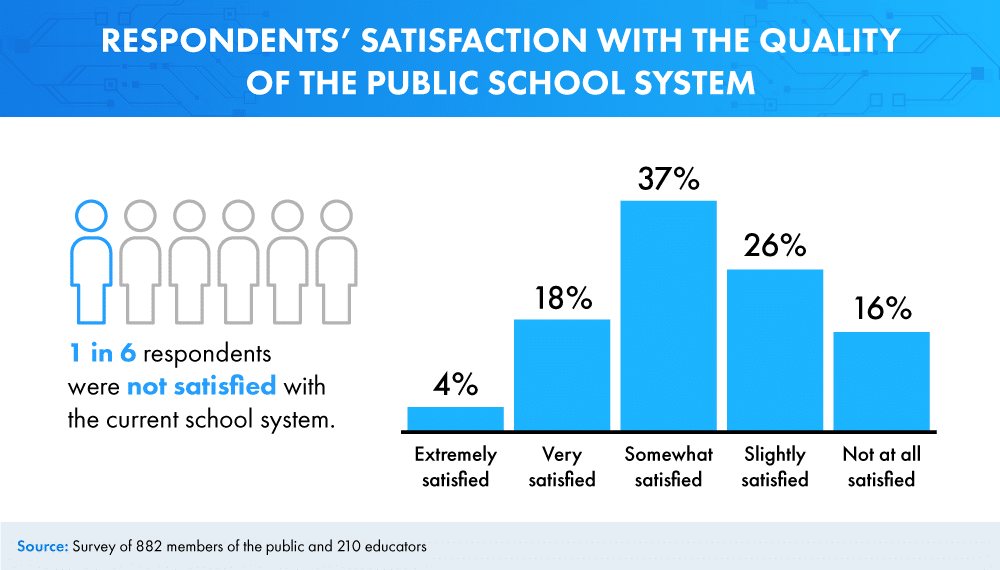
Is this what the U.S. education system is really doing? It has become increasingly noticeable that Americans are frustrated with how the current school system prepares their children for life after graduation. Should there be a new, more technologically advanced system put in place that takes each individual child’s learning ability into consideration, rather than categorizing them based on age?
We surveyed over 1,000 people about their thoughts on an AI-generated curriculum that does just that. Students of all ages are split up into groups based upon their learning and comprehension of a subject, instead of using their birth year as the only criteria for where they belong in school.
We utilized GPT-3 technology to learn what is most essential to include in the curriculum for subjects at different grade levels, as well as to make suggestions about issues such as class times, the length of the school day and what students should be focused on outside of the classroom.
Using the information gathered during our survey, let’s take a look at what people think about students taking AI-recommended courses, and (if given the chance) what their own refined version of school would look like based upon their past school experiences.
Out With the Old-School, in With the New
The first part of our study explores the opinions of educators and the general public to see if the grade organization aspect of the AI-designed school system holds any merit.
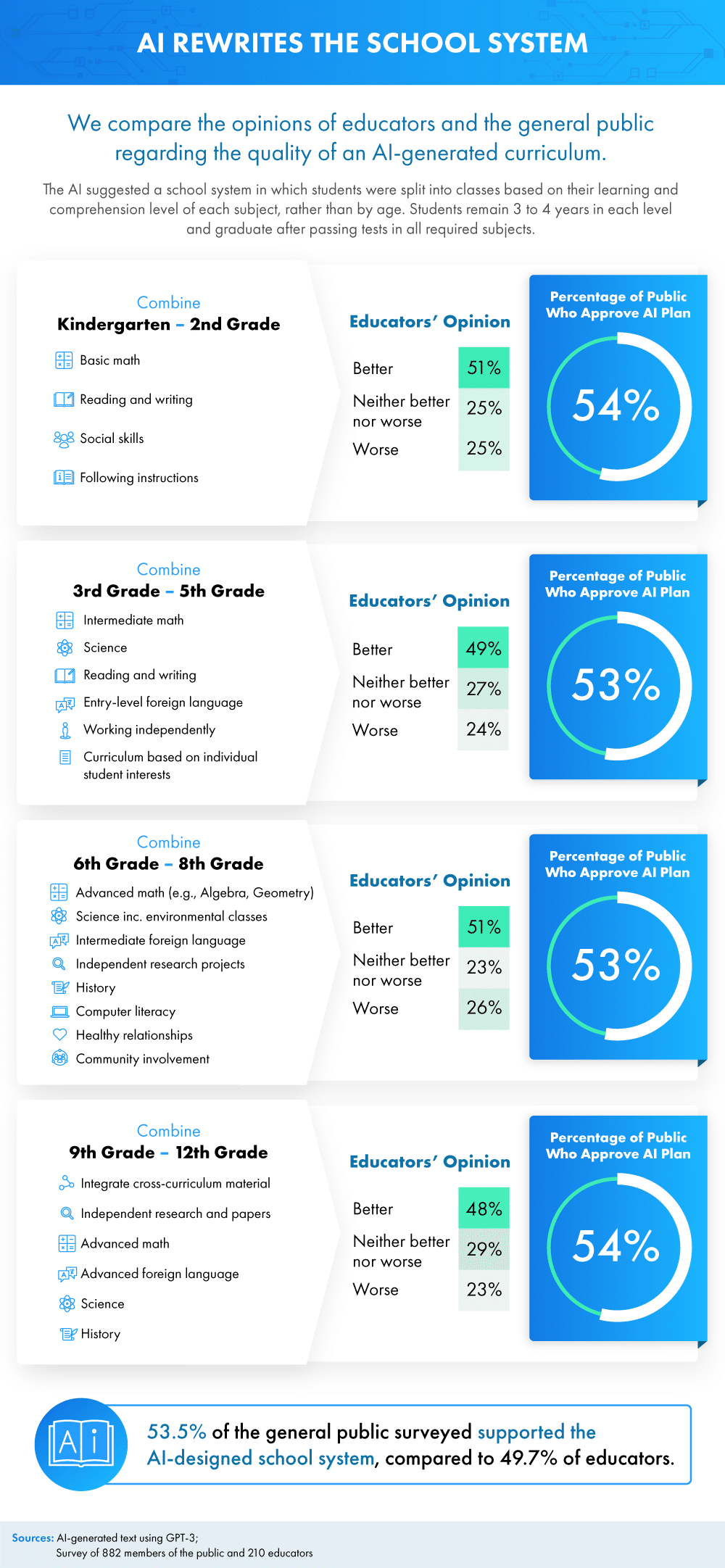
Public school teachers have become accustomed to specific standardized curricula; however, the new AI-influenced school system aims to rewrite these “old-school” traditions. One of the main things that AI suggested was to combine certain grades and their lessons. For example, the basic lessons that are taught during the years of kindergarten through second grade should all be grouped into one level of education. This includes things like basic math, reading, writing and social skills, such as playing nicely with other children and following instructions from teachers. Over half of the people surveyed agreed that this proposed plan is better than the traditional system currently in place.
The AI also proposed combining third through fifth grade, sixth through eighth grade, and ninth through 12th grade. All of these suggestions were supported by roughly half of both educators and the general public. Under this new curriculum, students would spend three to four years in each “grade” before moving on to the next level after passing the required testing for each subject.
Adjusting Class Time and Size
For most students, going to school is associated with waking up early and spending the better part of the day in a classroom surrounded by at least 20 of their peers. Is this truly the most effective way of learning?
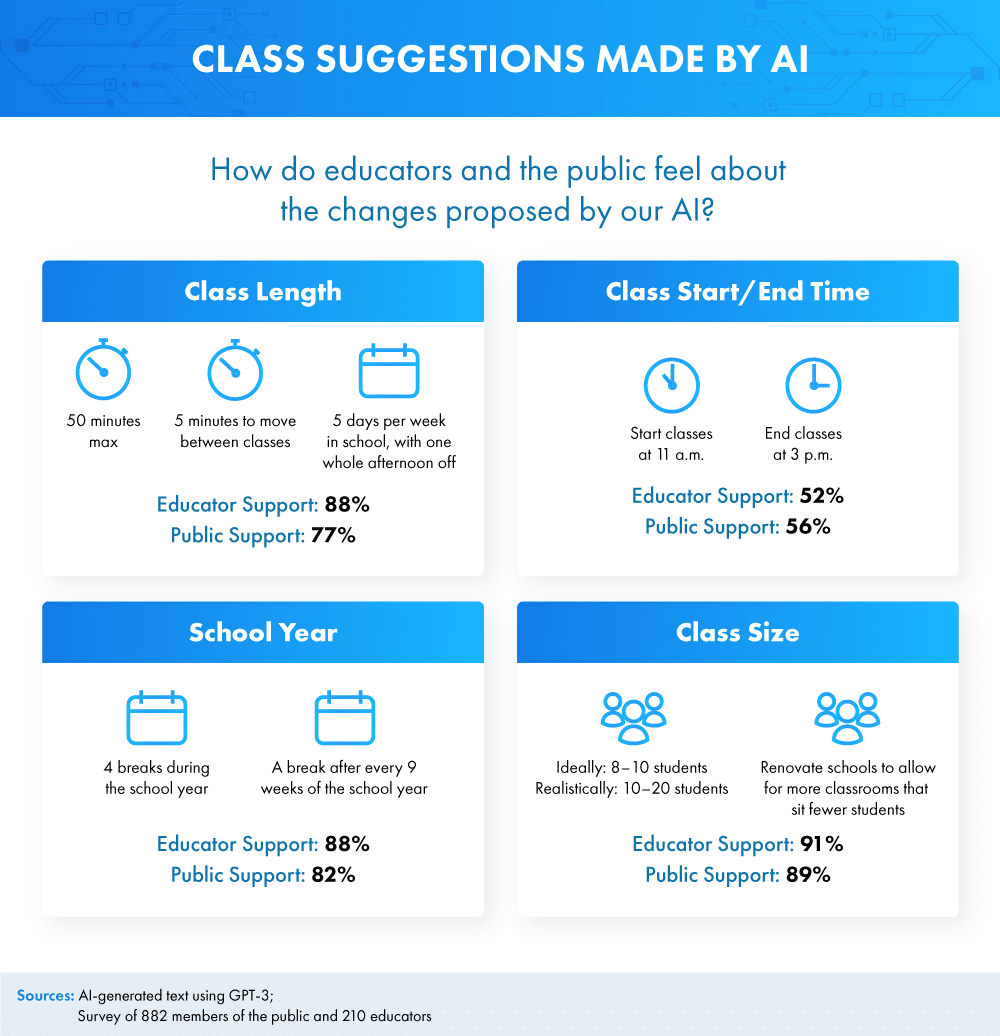
Let’s first address the time of day students are arriving at school. The typical start time for most middle and high schools is sometime around 8-8:30 a.m., but even the Centers for Disease Control and Prevention (CDC) says 8 a.m. is too early for adolescents in particular and can have an effect on students’ health, safety, and academic success. The CDC recommends a start time of 8:30 a.m. or later, which is in line with what the AI suggested. More than 50% of educators and the general public showed support for beginning the school day at the proposed 11 a.m. start time.
When it comes to classroom size, the average number of students in a self-contained classroom in 2018 was 15 to 16 and 18 to 19 in decompartmentalized classrooms. These numbers are in line with what AI recognizes as a realistic class size; however, AI suggested that the ideal number of students per classroom would be as few as 8 to 10. To achieve this, schools might need to spend their budget on renovations to allow room for a greater number of smaller sized classrooms. The majority of both educators and the general public were on board with these suggestions.
Overall, educators and the general public were all supportive – in many cases overwhelmingly – of the AI suggestions in regards to class start and end times, class length, class size, and school year breaks.
Test Scores Aren’t Everything
Test scores can make or break a student’s chance of graduating and getting into their preferred college or university, should it be their choice to pursue a secondary education. In essence, the grading system is responsible for whether they succeed in terms of schooling.
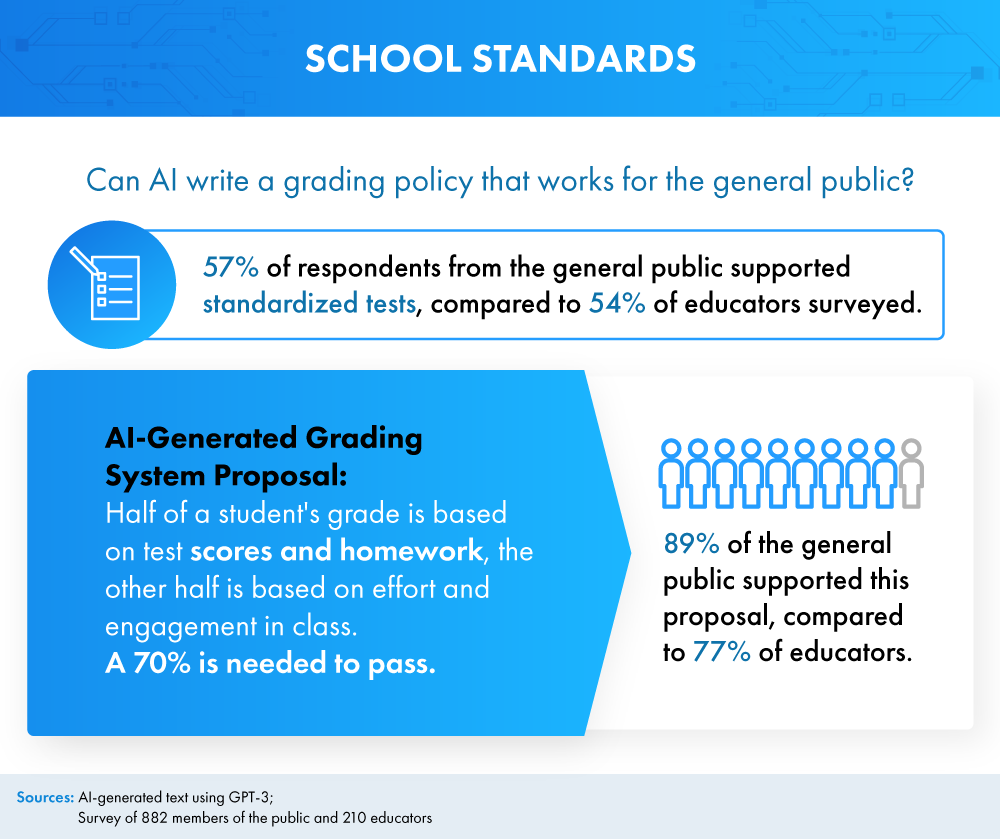
Standardized grading, with students scored according to their performance on a specific task, such as a test or homework assignment, has been the norm since the 1940’s. It’s around this time that the “A” through “F” scale as we know it today became a U.S. standard. However, it’s becoming more and more common to see educators rewarding their students based upon effort and engagement. The AI suggested a grading policy that combines both the academic and social aspects of school, with half of the grade coming from test and homework scores and the other half coming from the student’s level of classroom participation. Almost 90% of the general public and 77% of educators agreed with the AI’s proposed method.
Class Relevance
In the early years of grade school, class subjects are typical, covering topics such as English, math, science, and social studies. As students enter high school, the choices expand much further. Classes get a bit more specific, with some geared toward post-graduation career paths. We asked survey respondents which of their own high school classes they found to be the most useful and which ones they could have done without. We were also curious to hear what kind of classes they wish had been offered.
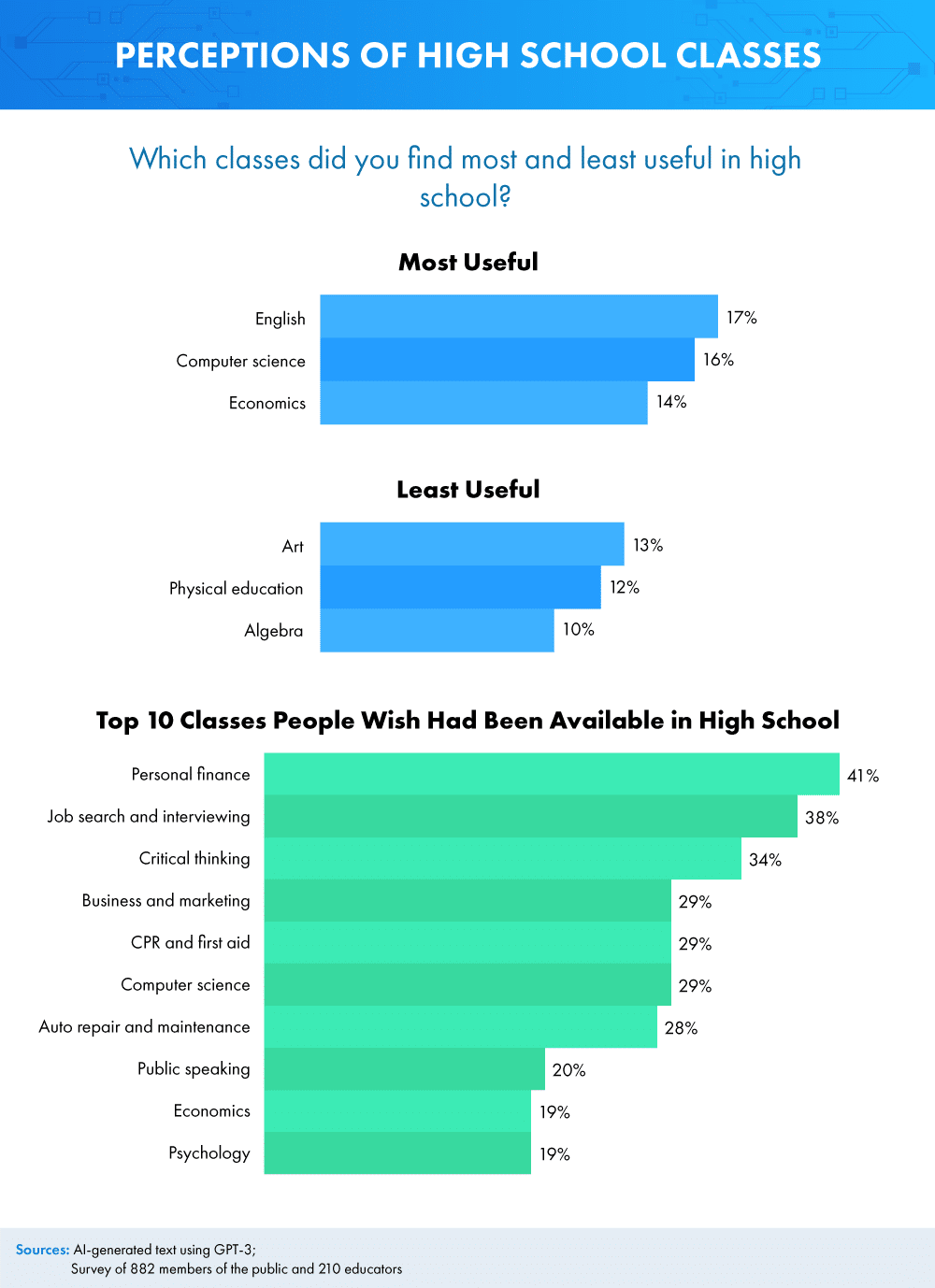
Interestingly, 8 out of the 10 classes listed were also suggested by AI. These classes reflect topics that focus on skills people need for everyday life, such as personal finance, critical thinking, and auto repair and maintenance. Classes like these that teach real-world life skills can prove very helpful to students as they embark upon life post-graduation.
Before the Cap and Gown
When students get so close to graduation they can practically taste it, they may also start to worry about whether they are ready to head out into the real world. Parents of these high school kids on the brink of graduation may also be concerned about this. They want to be sure their children have acquired the right skills and education needed to take care of themselves once they’ve flown the nest.
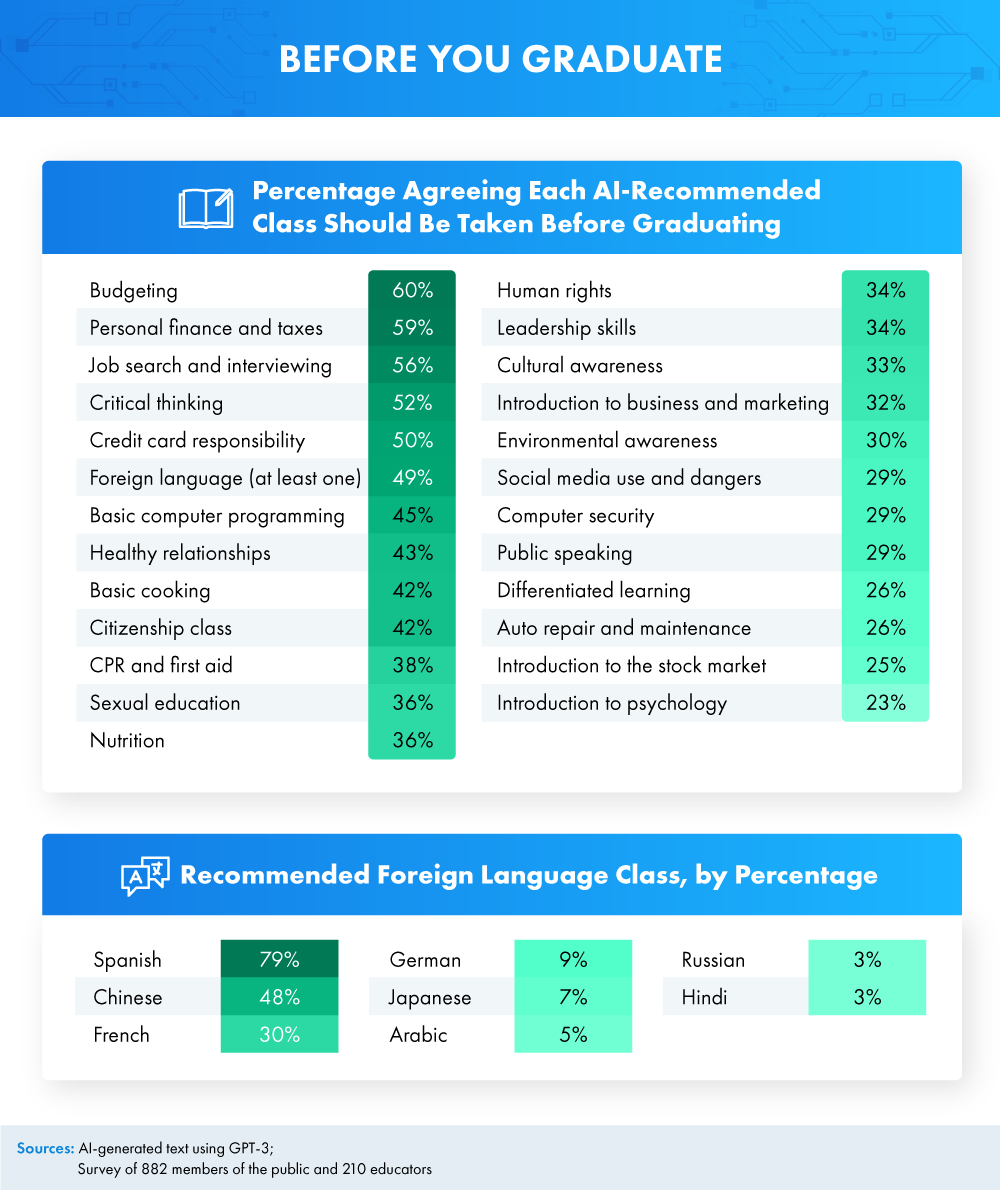
Frustration with the current school system is understandable for parents who want their children to receive lessons that go beyond the classroom and the world of academia. Oftentimes, there is not enough emphasis on real-world classes, much like the ones AI highly recommends should be included in the curriculum before students graduate high school.
Some of the AI-suggested classes and their benefits included the following:
- Personal finance and taxes. Additional finance-related classes include credit card responsibility and budgeting, all of which are crucial to being financially stable in life. Students should learn the basics about things like balancing a checkbook; understanding credit card interest and the potential harm of being in debt; creating and following a budget; and how to file for taxes before they turn 18 and are legally responsible for themselves and their bank accounts.
- Job search and interviewing. Learning how to give a good interview can greatly improve students’ communication skills. There is a lot of work that goes into planning for an interview. Without the proper training, there’s a chance anyone could go into their first one feeling unprepared and overwhelmed and not do as well as they would have had they been coached in the right way.
- Basic cooking. When the time comes for students to live on their own, they can’t live off ramen noodles and fast food. It’s not healthy or practical. As the Chinese philosopher Lao Tzu said, “If you give a man a fish, you feed him for a day. If you teach a man to fish, you feed him for a lifetime.”
- Social media use and dangers. Everything is on social media these days, both good and bad. Classes that focus on different social media platforms can be helpful for students in their careers, as most businesses utilize these tools as part of their marketing strategies and for sales opportunities. We also know that being so accessible on social media can prove dangerous in some respects. It’s not as cut and dry as teaching children to simply “not talk to strangers” anymore. There is a lot more to it now that technology is so much more advanced.
AI Is Taking Education to the Next Level
Our survey shows that the general public, as well as professional educators, are pretty much in agreement that an AI-designed school system would be beneficial for students. The AI-suggested changes could be the breath of fresh air needed to restore people’s faith in the education system. One of the most popular proposals was reduced class sizes. AI recommended to limit class sizes to 8 to 10 students, which has a multitude of benefits for both teachers and students. For one, teachers are able to give students more one-on-one, individualized attention, and in turn, students don’t feel lost among a sea of their peers.
Overall, survey respondents were in support of the AI-suggested changes. The future of education is on the horizon, and from what we’ve gathered, the public is ready for it. If you want to make sure you’re choosing the higher education option that is best for you or your child, you’ll want to start with BestValueSchools.org. Your degree preferences, subject interests, pricing needs, and other priorities can all be accommodated. The technology of BestValueSchools.org will ultimately connect you with the perfect school for you.
Methodology and Limitations
Generative Pre-trained Transformer 3 (GPT-3) is an autoregressive language model that uses deep learning to produce human-like texts. GPT-3 was asked to produce output for each aspect of the school curriculum, using identical prompts. This output was lightly edited for length and repetition, but not for content or fact-checking. The findings in this article are limited by small sample batches and are for exploratory purposes only. Future research on the capabilities of AI should approach this topic in a more rigorous way.
This study uses data from two surveys. A survey of 882 Americans was run on the Amazon Mechanical Turk survey platform where respondents were presented with a series of questions, including attention-check and disqualification questions. A second survey of 210 educators was run on the Prolific survey platform where respondents were prescreened as working in the education field. 47.3% of respondents identified as men, while 52.7% identified as women. The average age of respondents was 36 years old with respondents ranging from 20 to 75. This study has a 3% margin of error on a 95% confidence interval. Please note that survey responses are self-reported and are subject to issues, such as exaggeration, recency bias, and telescoping.
Fair Use Statement
Are you a parent of school-age children or know a parent of one who isn’t exactly impressed by the current education system? Feel free to use and share this article for all noncommercial purposes, but please remember to link back to our study to give credit to our contributors.

